Do you have a question about the Panasonic VIERA TH-L55ET5Z and is the answer not in the manual?
Essential safety guidelines and warnings for operating the TV.
Overview of standard and optional accessories for the TV.
Identification of buttons and controls on the remote and TV.
Instructions for connecting external devices and antennas to the TV.
Automatic search and storage of TV channels.
Basic TV operations and features for everyday use.
Advanced TV settings and features for enhanced viewing.
Proper handling procedures for the power plug and cord to prevent hazards.
Crucial guidelines for safely installing the TV unit.
Information and warnings regarding the TV's wireless network capabilities.
List and description of items included in the TV package.
Details on recommended accessories available for separate purchase.
Detailed explanation of each button on the remote control.
Identification of the TV's built-in control panel and indicators.
Guide on operating the TV using the remote control and on-screen menus.
Layout and identification of all connection terminals on the TV.
Illustrations and instructions for connecting mains lead and aerial.
Connection diagrams for various AV equipment like DVD players and camcorders.
Instructions for connecting the TV to a network environment.
Initial step to power on the TV for the tuning process.
Setting the geographical region for optimal channel tuning.
Choosing between Digital TV, Analogue TV, or starting auto tuning.
Configuring network settings for smart TV features.
Ensuring the TV is powered on to access VIERA Connect.
Steps to launch and navigate the VIERA Connect interface.
Procedure to turn on the TV for viewing.
Switching between digital and analogue TV reception modes.
Methods for selecting TV channels, including from a list.
Additional TV functions like information banner and subtitles.
Instant adjustment of picture settings like aspect ratio and sound modes.
Setting the TV to automatically switch to standby after a period.
Changing the image aspect ratio for optimal viewing.
Choosing the TV Guide display mode (Portrait or Landscape).
Navigating and viewing the electronic program guide.
Selecting and viewing a program directly from the TV Guide.
Accessing and browsing the Freeview electronic program guide.
Activating the teletext service on the TV.
Navigating and selecting teletext pages.
Revealing hidden information on teletext pages.
Accessing the main index page for teletext.
Powering on the TV before connecting external equipment.
Opening the menu to select input sources.
Choosing the correct input source for connected devices.
Displaying the selected input source content on the TV screen.
Important safety warnings related to 3D eyewear.
Precautions for safe and comfortable use of 3D eyewear.
Guidelines for viewing 3D content and potential health considerations.
Instructions for proper storage and cleaning of 3D eyewear.
Methods for enjoying 3D content on the TV.
Switching between 2D and 3D viewing modes using the 3D button.
Manual adjustment of 3D format settings for optimal display.
Accessing the main menu to adjust TV settings.
Navigating to the Picture settings menu.
Accessing the specific menu for 3D image adjustments.
Adjusting 3D depth, detection, and other related settings.
Accessing the VIERA TOOLS menu to view feature icons.
Choosing a specific feature from the VIERA TOOLS menu.
Instructions for using specific VIERA TOOLS features like VIERA Link.
Opening the main menu to access TV settings.
Navigating through different menu categories like Picture, Sound, Setup.
Choosing specific settings within a menu category for adjustment.
Using the on-screen keyboard to input text for settings.
Selecting preferred picture modes (Dynamic, Cinema, Game, etc.).
Adjusting fundamental picture quality parameters.
Adjusting the picture hue for NTSC signal, Component, and HDMI input.
Setting the overall colour tone of the picture.
Options for turning the screen off or adjusting display settings.
Accessing advanced picture settings like motion enhancement and film mode.
Menu section for adjusting sound output and modes.
Adjusting the level of low-frequency sound output.
Adjusting the level of high-frequency sound output.
Fine-tuning sound frequency levels for personalized audio.
Adjusting the volume balance between left and right speakers.
Selecting preferred audio track settings for digital TV.
Setting the initial digital audio output signal.
Configuring HDMI input signals for optimal sound and video.
Settings for audio narration for visually impaired users.
Network connection, settings, and status management.
Setting timers for recording or reminders.
General TV setup options including energy saving and child lock.
Options for channel tuning, editing, and favourites management.
Customizing display options like teletext mode and banner timeouts.
Configuration options for VIERA Link and connected devices.
System-related settings like software updates and shipping condition.
Miscellaneous settings including power saving and region selection.
Choosing between TV modes for tuning operations.
Accessing the setup menu for channel management.
Choosing the specific tuning menu for digital or analogue channels.
Selecting functions like Favourites Edit, Auto Tuning, or Channel List.
Modifying the list of favorite TV channels.
Hiding or editing channels in the channel list.
Swapping or renaming channel positions.
Automatically retuning all available channels.
Manually tuning digital TV channels.
Manually tuning analogue TV channels.
Automatically updating the channel list with new channels.
Checking the quality and strength of the digital TV signal.
Performing auto tuning directly from the TV's physical buttons.
Using the menu to set reminders or recordings.
Selecting the TV mode for timer programming.
Accessing the Timer menu.
Choosing the timer programming function.
Setting up child lock for channels and inputs.
Procedure for changing the existing child lock PIN.
Setting parental rating restrictions for digital TV programs.
Resetting the TV to its original factory settings.
Procedures for updating the TV's software automatically or manually.
Selecting the correct input source for PC connection.
Choosing the PC input mode from the selection menu.
Adjusting PC display settings like resolution and position.
Accessing the Picture settings menu.
Choosing and setting the desired viewing mode for the picture.
Entering the advanced settings for detailed picture adjustments.
Fine-tuning picture elements like white balance and gamma.
Preparing USB HDD and SD Card for recording.
Accessing the setup menu for recording configurations.
Choosing the recording setup option.
Formatting and setting up USB HDD or SD Card for recording.
Configuring the USB HDD for recording.
Formatting the SD Card for proper operation.
Instructions for recording TV programs to storage devices.
Recording the current program instantly.
Continuously recording the current program for later playback.
Correct procedures for inserting and removing media cards.
Launching the Media Player application.
Choosing the media source (USB HDD, SD Card, etc.).
Selecting the type of media file to play (Photo, Video, Music).
Navigating and playing media files within the player.
Switching between different media modes within the player.
Viewing and managing photo files.
Displaying photos one by one.
Viewing photos in an automated slideshow.
Organizing media files by folder or date.
Creating 3D photos from pairs of images.
Viewing 3D photos with the necessary eyewear.
Configuring settings for photo slideshows.
Customizing slideshow effects, interval, and background music.
Playing back video files and recorded TV programs.
Viewing video files from media storage.
Playing back specific scenes from video titles.
Controls for playback operations like pause, stop, and search.
Configuring video playback settings like preview and aspect ratio.
Accessing and playing back recorded TV content.
Selecting and playing media files from a list.
Managing recorded content, such as creating groups or changing protection status.
Removing selected media files.
Advanced playback controls like chapter selection and A-B repeat.
Playing back content from a chapter list for USB HDD recordings.
Switching between connected media devices.
Configuring audio output settings for video content.
Playing back music files from media storage.
Configuring music playback settings like repeat and background music.
Information about DLNA Certified technology for home networking.
Using the TV as a media server to share content.
Controlling the TV using DLNA Certified equipment.
Accessing internet services and online content through VIERA Connect.
Diagrams and instructions for connecting the TV to a network.
Configuration process for network connections.
Setting up controls for network-linked equipment.
Configuring network settings for wired LAN connections.
Setting IP and DNS addresses automatically or manually.
Setting up proxy server address.
Setting the proxy port number.
Configuring network settings for wireless connections.
Testing the network connection status.
Inputting the wireless network encryption key.
Accessing software updates for the TV.
Choosing a media server on the network.
Browsing and selecting files from a media server.
Viewing and managing photo files from DLNA servers.
Viewing photos in a slideshow format.
Playing video files from DLNA servers.
Playing music files from DLNA servers.
Controlling a connected DIGA Recorder via DLNA.
Accessing content-specific settings for photos, videos, and music.
Configuring audio output for video content.
Accessing and using VIERA Connect features.
Overview of features and capabilities enabled by VIERA Link.
Diagrams illustrating HDMI connections for VIERA Link.
Details on HDMI and audio connections for VIERA Link.
Controlling connected equipment using VIERA Link.
Information on HDMI Inter-Operability and HDAVI Control.
Steps needed before setting up VIERA Link.
Overview of features like channel download and easy playback.
Saving power by automatically putting connected equipment in standby.
Automatically putting unused equipment into standby mode.
Recording the current program directly to a DIGA Recorder.
Pausing and resuming live TV programs.
Operating connected equipment menus using the TV remote.
Accessing the VIERA Link Control menu.
Choosing the type of connected equipment to control.
Controlling the selected equipment's menu via remote.
Selecting audio output between TV speakers and external speakers.
Configuring audio output for home cinema or TV speakers.
Enjoying multi-channel audio via amplifier connection.
Connecting HDMI compatible devices like players and camcorders.
Connecting a DVD player for viewing and listening.
Connecting camcorders and game consoles.
Connecting external speakers or amplifiers.
Connecting headphones for private listening.
Connecting USB storage devices like HDD and cameras.
Connecting a computer to the TV for display and sound.
Table detailing equipment compatibility with TV terminals.
List of channel frequencies for analogue TV reception.
Classification ratings for digital TV programs.
Selecting sound modes for analogue TV broadcasts.
List of supported file formats for media playback.
Supported file formats and specifications for photo files.
Supported file formats and codecs for video playback.
Supported video container formats and codecs.
Supported audio file formats and restrictions.
Information about DivX certified video playback.
Using subtitle files with DivX videos.
Procedure to obtain the DivX VOD registration code.
Information on SD Card, USB Flash Memory, and USB HDD.
Specifications and usage of SD Cards for playback and recording.
Specifications and usage of USB Flash Memory for playback.
Specifications and usage of USB HDDs for recording and playback.
Guidelines for connecting HDMI compatible equipment.
Instructions for connecting a PC to the TV.
Connecting USB keyboards, gamepads, and other devices.
Using numeric buttons to input characters.
Lists compatible input signals for Component, HDMI, and PC connections.
Troubleshooting steps for image noise or shadow effects.
Troubleshooting steps when the TV has no picture or sound.
Troubleshooting steps for a black and white picture display.
Troubleshooting steps for VIERA Link connection issues.
Troubleshooting audio issues like no sound or distorted sound.
Troubleshooting problems related to viewing 3D images.
Troubleshooting issues when connected via HDMI.
Troubleshooting network connectivity problems.
Troubleshooting issues specific to digital TV reception.
Troubleshooting for general TV issues like power and remote control.
Instructions for cleaning the TV's exterior parts.
Guidelines for cleaning the mains plug.
General specifications for the TV models.
Audio specifications including speaker output and headphone jack.
Details on TV broadcast reception systems and frequency bands.
Specifications of various input/output connection terminals.
Continued specifications for TV models, including power and dimensions.
Power rating and consumption details for the TV.
Specifications of the TV's display panel.
Specifications for the 3D eyewear accessory.



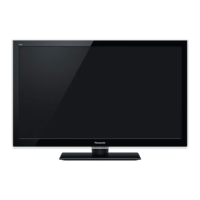


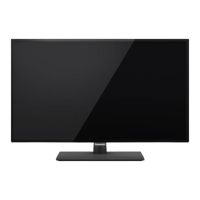

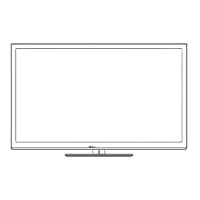

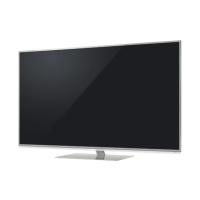
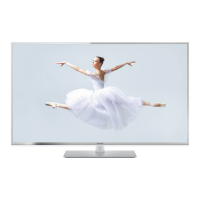
